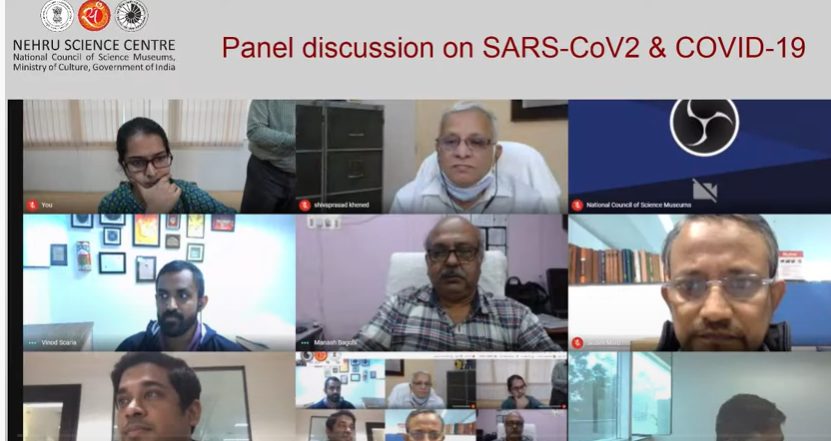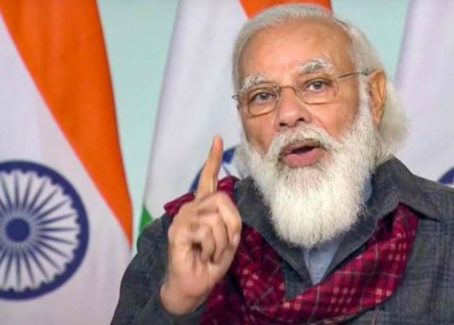
COVID-19 is a pandemic which has caused a paradigm shift in understanding of pathogens and that has been possible because of a merger of two sciences – age-old microbiology and the new technology of genomics, stated Dr. Vinod Scaria, Senior Scientist, Genome Informatics at the at CSIR-Institute of Genomics and Integrative Biology (CSIR-IGIB). Dr. Scaria said, right from the early days of the SARS-COV-2 pandemic, there has not been any attempt to culture, isolate and purify this micro-organism. Rather patients’ samples were directly taken up for RNA extraction, sequencing and further analysis. He was speaking in an online panel discussion on SARS-CoV2 and COVID-19, organized by the Nehru Science Centre and CSIR-IGIB. The other panellists included eminent scientists Dr. Debojyoti Chakraborty and Dr. Souvik Maiti who teamed up to bring out the CRISPR technology based FELUDA Covid-19 test kit, and Dr.Shantanu Sengupta who coordinated CSIR’s COVID-19 sero-survey.
Speaking about genetic mutation of SARS-CoV-2, Dr. Scaria stated, “One thing that has been consistently found from the genome sequences of SARS-CoV2 is that the virus mutates and the mutation or substitution rate occurs at a uniform manner across the genome”. The RNA virus has quite a constant rate of mutation which is approximately 3.7 per month or 1 per week. “As the virus gets transmitted from individual to individual over a period of time, it accumulates mutations and some individuals spread it much further and that is how a genetic lineage emerges”, stated the senior scientist. In the early stages of SARS-CoV2 pandemic (till April 2020), 10 genetic lineages from 2000 genomes across the world, showed geographical preponderance. In the later stages, many of this changed which helps to make an assessment of the disease’s progression, further informed Dr. Scaria. In India, there are around 4000 different genome sequences of SARS-CoV2 deposited in labs, hospitals, research institutes across the country. In India, we find only 6 out of the 10 different lineages found globally. There is a unique genetic lineage called ‘I/A3i clade’ in India, informed Dr. Scaria. ‘I/A3i’ genetic lineage of SARS-CoV2 in India could be traced across different states in different periods. There’s a remarkable difference in preponderance of this genetic lineage in various parts of India. It came from a super-spreader event in Feb-March 2020, stated the senior scientist. How is the SARS-CoV-2 Virus evolving? In answer to this, Dr. Scaria states, “the ‘I/A3i clade’ genetic lineage has a significantly lower rate of substitution in comparison to the predominant ‘A2a clade’ in the country, and what we understand is that it would eventually die out “. The science of genomics has also been helpful in understanding the cases of COVID-19 re-infection, he informed. “First report of SARS-CoV-2 reinfection in the country was done by IGIB. It revealed that there is a significant difference in the genetic lineages of the virus in the two episodes”, informed Dr. Scaria.
One of the beneficial effects of this COVID-19 pandemic is that it has made science reach everyone’s home and scientific terms and processes are being discussed by laymen, feels Dr. Debojyoti Chakravorty. CRISPR technology is the basis of the COVID-19 paper-strip test kit he developed along with Dr. Souvik Maiti and a team of young researchers. It was recently in the limelight because the recipients of Nobel Prize in Chemistry 2020 have also employed CRISPR method for human genome editing. Dr. Chakraborty opined, “This field has seen several heroes and tremendous development in the last 30-40 years to come to a point where we are talking about editing the human genome”. Explaining the paper-strip based test called FELUDA, which is the name of a detective character in Satyajit Ray’s fiction, he said, “CRISPR has entered into this field because COVID-19 testing relies on a protein going and interacting with genetic material. The COVID-19 scenario has brought up a large number of CRISPR based tests which utilize majorly 3 different types of proteins – Cas9, Cas12 and Cas13 proteins. FELUDA uses an alternate form of Cas 9 called Francisella novicida (FnCas9)”, explained Dr. Chakraborty. The acronym stands for ‘FNCAS9 Editor-Limited Uniform Detection Assay’. This diagnostic method works on the principle that FnCas9 protein is highly specific to point mutations in terms of discriminating between two substrates that are different by a single mismatch. In this innovation, there has been combination of CRISPR biology & paper-strip chemistry, where two bands on a strip makes sure that the patient is positive, while a single band makes sure the sample is negative. “The entire process can be completed in an hour, does not require a quantitative real-time PCR machine which costs around Rs 70 lakh and gets done on a simple PCR machine which costs around Rs 70,000-80,000/-. Hence, one can scale up COVID-19 Testing by almost twenty-fold at the same site and cost of a QRTPCR machine”, further explained the senior scientist. Like in Ray’s fictional novel, detective Feluda is assisted by his cousin Topse and friend Jatayu in solving mysteries, a machine-learning app TOPSE (True Outcome Predicted from Strip Evaluation) and JATAYU (Junction for the Analysis and Target Design for Your FELUDA assay) web-server for nucleotide sequences has also been developed for detailed study and further research of the SARS-CoV-2 genome.
Explaining the science behind sero-surveys, Dr. Sengupta, Senior Principal Scientist of Cardiovascular Disease Biology at IGIB, explained, when the SARS-COV-2 infection started, there was an interest about how long the virus will be stable, will there be an infection and so on. It is important to understand the prevalence of these antibodies to assess the prevalence of SARS-Cov-2 load in our population. It is also important to understand how long these antibodies will be there in our system which will help in protection against re-infection, stated Dr. Sengupta. In the Pan-India serological study conducted across all the 38 CSIR laboratories, blood samples were collected for the first phase of the study between June to September. Presently, follow-up is being done in every three months for all the people who were found to be antibody-positive. The Phase-I data reveals that the sero-positivity for Pan-India is about 10.1%. Explaining ‘herd-immunity’, Dr. Sengupta stated, it generally comes when there is 60-70% sero-positivity across the country. “We are still far-far away from herd-immunity and we need to have vaccines to generate this herd-immunity”, said the senior scientist. In the month of September, places like Trivandrum, Nagpur, Goa, Palampur, Dehra Dun, Bhubaneswar had sero positivity of less than 5%. The infectivity in these places were found to rise after a period of 30 days. Hence, sero-surveys can predict future trends also, stated Dr. Sengupta. Low sero-positivity is a marker for the risk of future transmission of the virus. Serological assays have also shown that antibodies remain present for at least 3 months and, in some cases, upto 6 months also, which means the individual with antibodies remain protected till this period, if not infected with a different strain again. This is an important strategy for the purpose of vaccination, remarked Dr. Sengupta. Serological study is important for prioritizing population groups for vaccination. In this context, he stated, “A person having antibodies may not be the right candidate to get vaccinated in the first phase”. Importance of sero-survey is also reflected by the fact that 75% of the people with antibodies have been found to be asymptomatic, he further stated.
Nehru Science Centre, under the National Council of Science Museums, an autonomous body of the Union Ministry of Culture, works to develop scientific attitude and temper and to create, inculcate and sustain a general awareness amongst the people. With such an aim, such panel discussions and webinars have been organized since coronavirus lockdown to popularize science amongst general public, especially young students and children.
";

